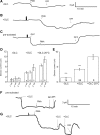Strong glucose dependence of electron current in human monocytes
- PMID: 22012327
- PMCID: PMC3328910
- DOI: 10.1152/ajpcell.00335.2011
Strong glucose dependence of electron current in human monocytes
Abstract
Reactive oxygen species (ROS) production by human monocytes differs profoundly from that by neutrophils and eosinophils in its dependence on external media glucose. Activated granulocytes produce vast amounts of ROS, even in the absence of glucose. Human peripheral blood monocytes (PBM), in contrast, are suspected not to be able to produce any ROS if glucose is absent from the media. Here we compare ROS production by monocytes and neutrophils, measured electrophysiologically on a single-cell level. Perforated-patch-clamp measurements revealed that electron current appeared after stimulation of PBM with phorbol myristate acetate. Electron current reflects the translocation of electrons through the NADPH oxidase, the main source of ROS production. The electron current was nearly abolished by omitting glucose from the media. Furthermore, in preactivated glucose-deprived cells, electron current appeared immediately with the addition of glucose to the bath. To characterize glucose dependence of PBM further, NADPH oxidase activity was assessed as hydrogen peroxide (H(2)O(2)) production and was recorded fluorometrically. H(2)O(2) production exhibited similar glucose dependence as did electron current. We show fundamental differences in the glucose dependence of ROS in human monocytes compared with human neutrophils.
Figures



Similar articles
-
Increased monocyte-derived reactive oxygen species in type 2 diabetes: role of endoplasmic reticulum stress.Exp Physiol. 2017 Feb 1;102(2):139-153. doi: 10.1113/EP085794. Epub 2017 Jan 10. Exp Physiol. 2017. PMID: 27859785 Free PMC article.
-
Nonstructural 3 protein of hepatitis C virus triggers an oxidative burst in human monocytes via activation of NADPH oxidase.J Biol Chem. 2001 Jun 22;276(25):23077-83. doi: 10.1074/jbc.M100698200. Epub 2001 Apr 13. J Biol Chem. 2001. PMID: 11304537
-
Glucose-6-Phosphate Dehydrogenase Deficiency Activates Endothelial Cell and Leukocyte Adhesion Mediated via the TGFβ/NADPH Oxidases/ROS Signaling Pathway.Int J Mol Sci. 2020 Oct 10;21(20):7474. doi: 10.3390/ijms21207474. Int J Mol Sci. 2020. PMID: 33050491 Free PMC article.
-
Neutrophils to the ROScue: Mechanisms of NADPH Oxidase Activation and Bacterial Resistance.Front Cell Infect Microbiol. 2017 Aug 25;7:373. doi: 10.3389/fcimb.2017.00373. eCollection 2017. Front Cell Infect Microbiol. 2017. PMID: 28890882 Free PMC article. Review.
-
Production of reactive oxygen species in the diabetic heart. Roles of mitochondria and NADPH oxidase.Circ J. 2014;78(2):300-6. doi: 10.1253/circj.cj-13-1187. Epub 2013 Dec 13. Circ J. 2014. PMID: 24334638 Review.
Cited by
-
The intimate and controversial relationship between voltage-gated proton channels and the phagocyte NADPH oxidase.Immunol Rev. 2016 Sep;273(1):194-218. doi: 10.1111/imr.12437. Immunol Rev. 2016. PMID: 27558336 Free PMC article. Review.
-
Consequences of dimerization of the voltage-gated proton channel.Prog Mol Biol Transl Sci. 2013;117:335-60. doi: 10.1016/B978-0-12-386931-9.00012-X. Prog Mol Biol Transl Sci. 2013. PMID: 23663974 Free PMC article. Review.
-
The Voltage-Gated Proton Channel: A Riddle, Wrapped in a Mystery, inside an Enigma.Biochemistry. 2015 Jun 2;54(21):3250-68. doi: 10.1021/acs.biochem.5b00353. Epub 2015 May 20. Biochemistry. 2015. PMID: 25964989 Free PMC article. Review.
-
Proton channels in non-phagocytic cells of the immune system.Wiley Interdiscip Rev Membr Transp Signal. 2013 Mar;2(2):65-73. doi: 10.1002/wmts.78. Wiley Interdiscip Rev Membr Transp Signal. 2013. PMID: 23710424 Free PMC article.
-
Voltage-Gated Proton Channels in the Tree of Life.Biomolecules. 2023 Jun 24;13(7):1035. doi: 10.3390/biom13071035. Biomolecules. 2023. PMID: 37509071 Free PMC article. Review.
References
-
- Albe KR, Butler MH, Wright BE. Cellular concentrations of enzymes and their substrates. J Theor Biol 143: 163–195, 1990 - PubMed
-
- Bankers-Fulbright JL, Gleich GJ, Kephart GM, Kita H, O'Grady SM. Regulation of eosinophil membrane depolarization during NADPH oxidase activation. J Cell Sci 116: 3221–3226, 2003 - PubMed
-
- Bedard K, Krause KH. The NOX family of ROS-generating NADPH oxidases: physiology and pathophysiology. Physiol Rev 87: 245–313, 2007 - PubMed
Publication types
MeSH terms
Substances
Grants and funding
LinkOut - more resources
Full Text Sources

